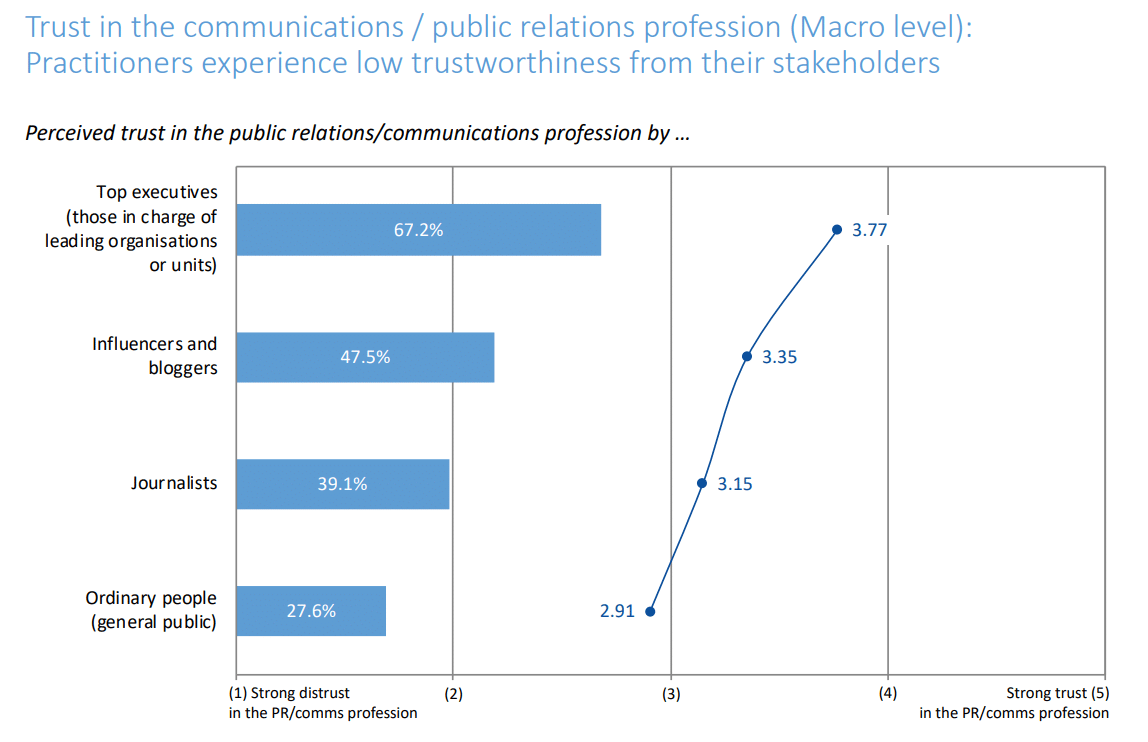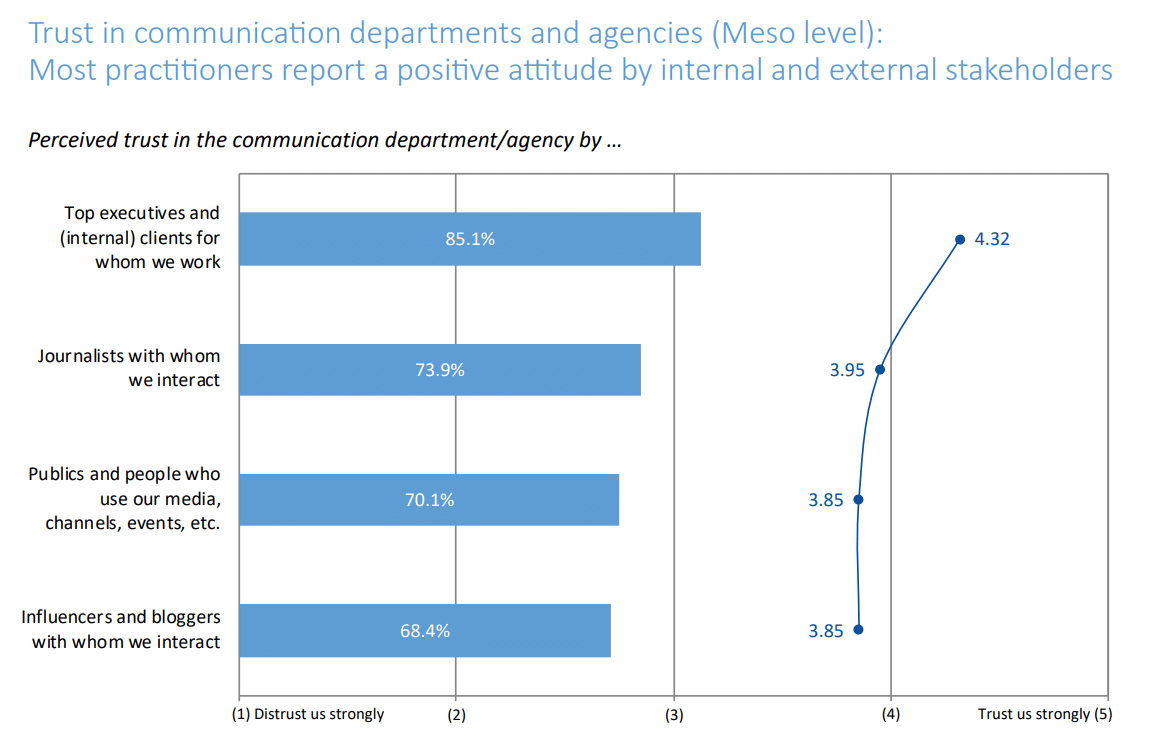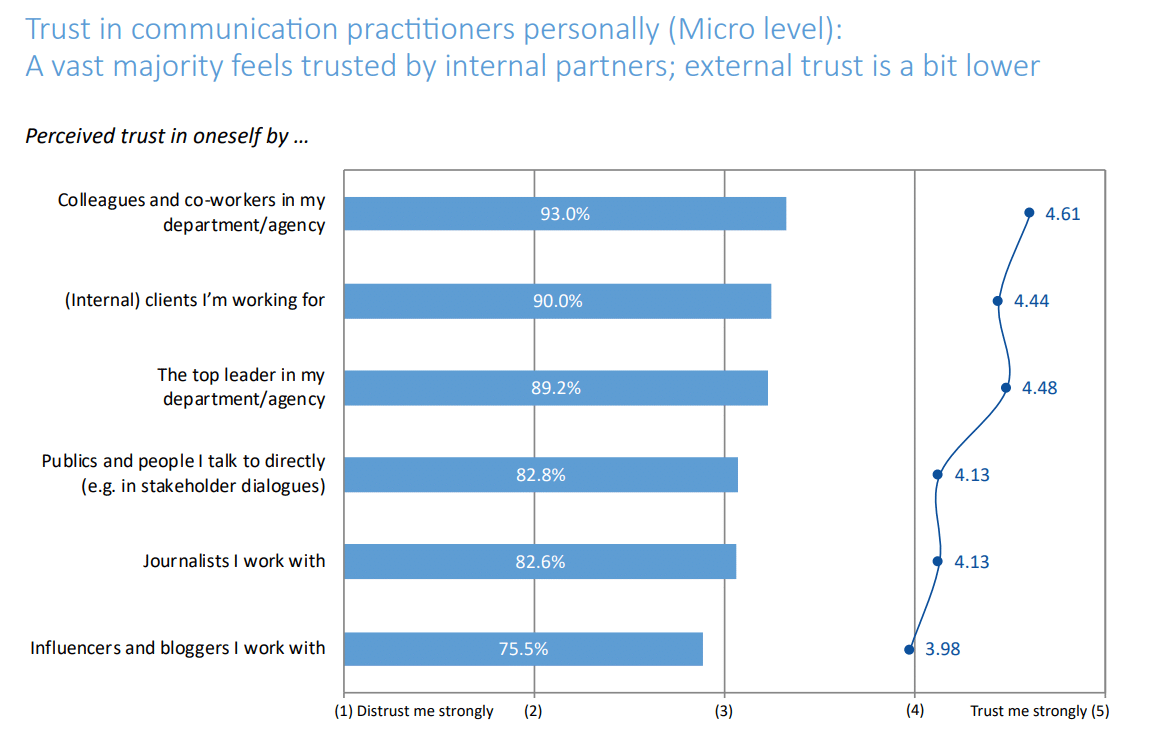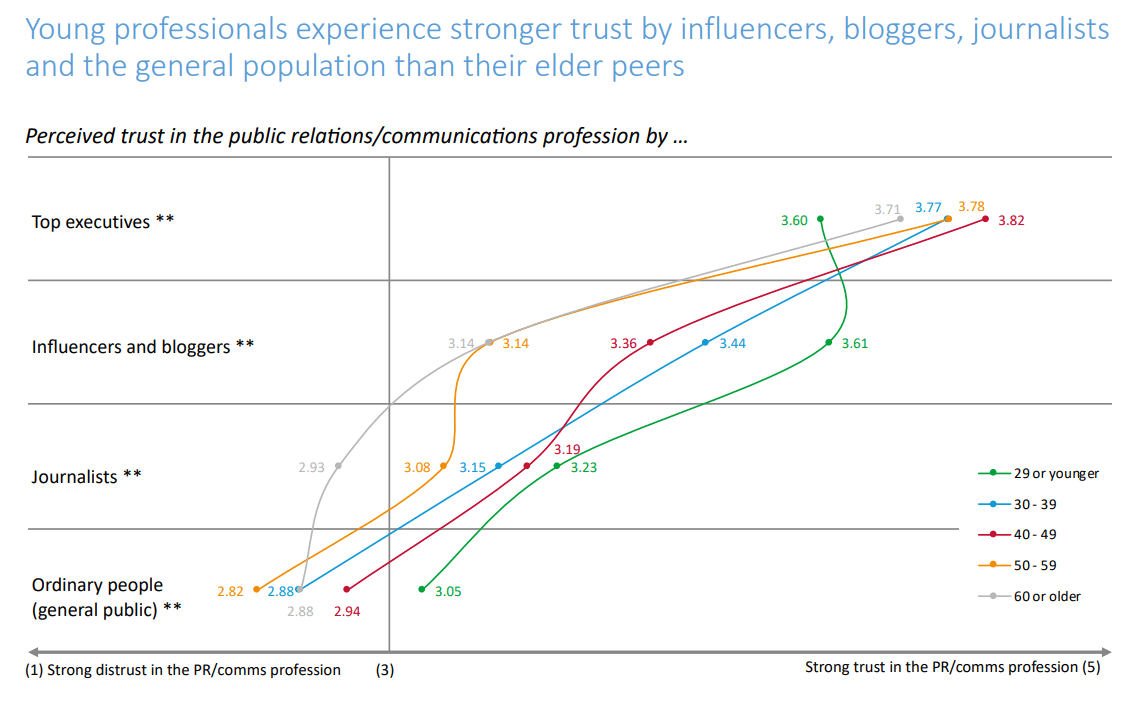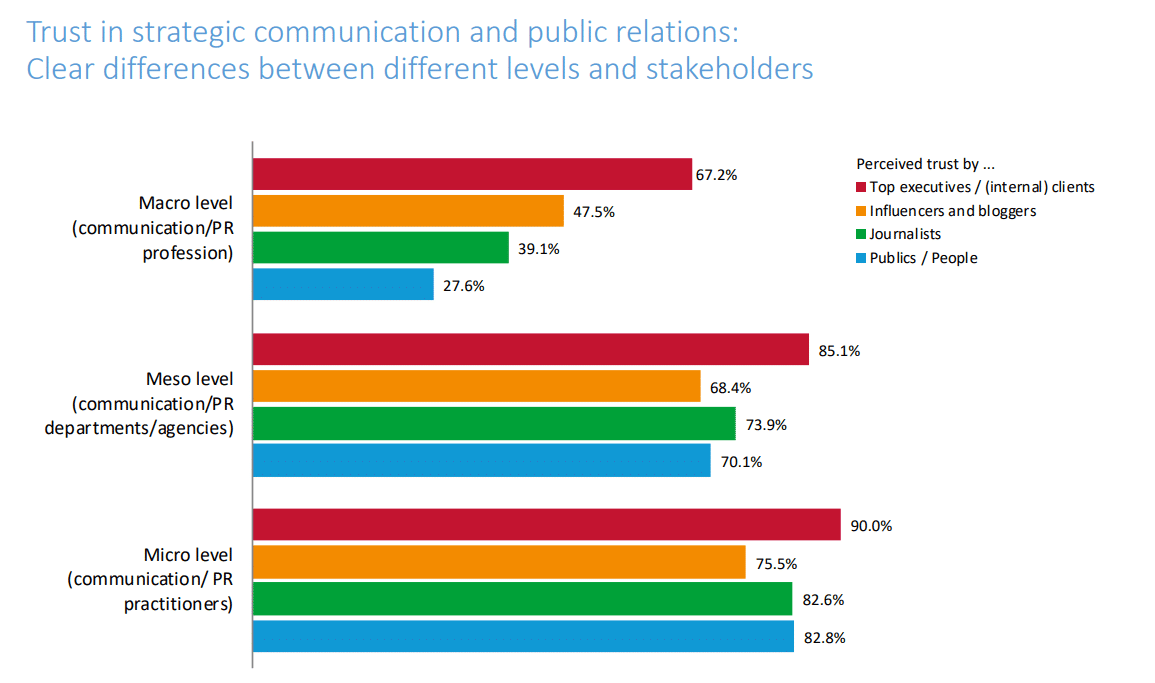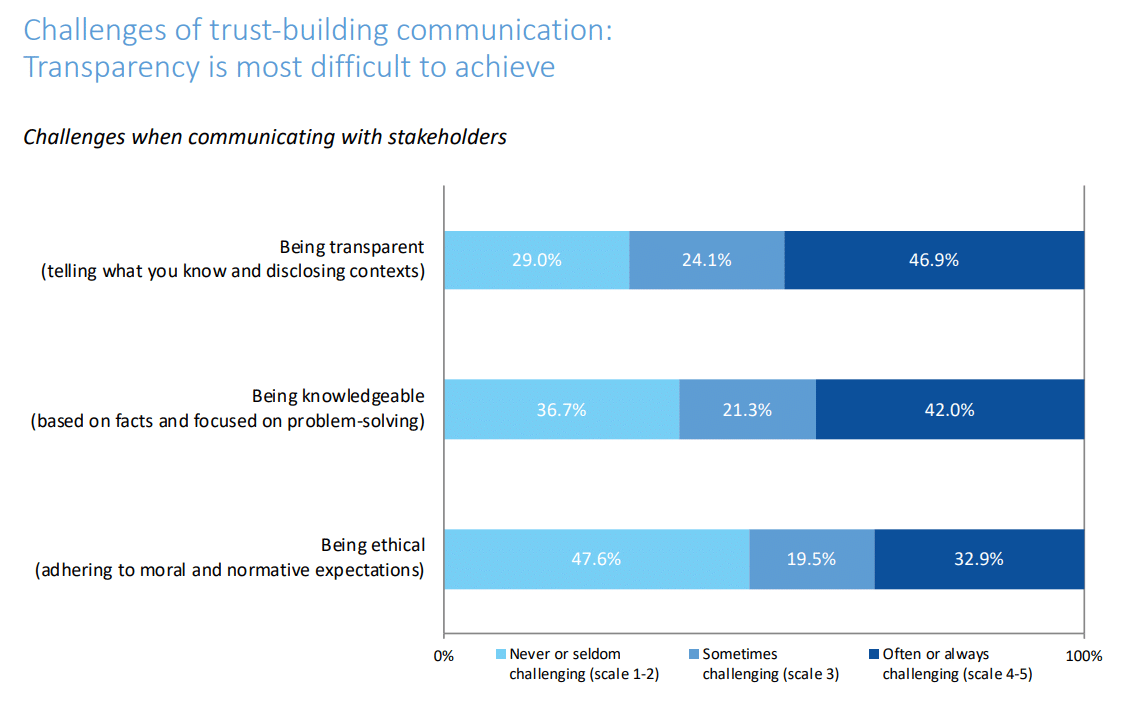“In the light of declining trust in the mass media, this year’s European Communication Monitor reveals a striking trust gap in the communications profession—communication professionals feel trusted by their personal interaction partners, but expect low levels of trust in the branch among the general population,” said Professor Ansgar Zerfass of Leipzig University in Germany and lead researcher of the survey, in a news release. “Enabling trustworthy advocates to communication functions and enhancing organizational transparency where appropriate are becoming key tasks for communication practitioners.”
Key findings of the report:
- Communication practitioners experience a low level of trust in their profession, but feel confident on a personal level with their colleagues, bosses, clients and audiences
- External experts and top management are rated as the most trusted organizational advocates with marketing/sales and communications lagging behind
- Artificial Intelligence is expected to impact the profession, but communication practitioners lack competencies and experience
- Sponsored content is frequently used by every second organization in Europe
- There are significant differences between countries, as well as companies and non-profits across Europe
“Communications must get to grips with technological developments like the rise of Artificial Intelligence and new forms of content creation and distribution,” added Hans Koeleman, president of the European Association of Communication Directors (EACD) and chief corporate communications and CSR officer at KPN in the Netherlands, in the release. “The ECM 2019 investigated on their impact and usage, and compared their perception among respondents from different countries, disciplines, and hierarchical levels. Our results deliver crucial insights for all communication practitioners who will have to tackle these technologies now or in the near future.”
Trust in communications: Striking differences between macro, meso and micro perspective
In many countries, trust in the mass media and journalism is declining. This loss of trust might also be true for other communicators, especially those who communicate on behalf of companies and organizations. This is a key challenge for the profession, as communicators need to be trusted by the people they work for, such as senior executives and internal clients. Additionally, they are also dependent on the trust of journalists, bloggers, influencers and general public.
“The European Communication Monitor 2019 is the first study that has explored trust in communications across different levels, stakeholders and countries,” said Zerfass.
Results show that communication professionals experience low levels of trust in their line of work. The profession is only trusted by two third of top executives (67 percent), and by a minority of influencers and bloggers (47 percent), journalists (39 percent) and ordinary people (27 percent). But respondents are more positive about the perceived trust in their departments or agencies. 85 percent of the respondents reported a positive attitude by executives or by clients, followed by 73 percent perceived trust from journalists, 70 percent from the general public and 68 percent from influencers and bloggers. Professionals are the most positive about the perceived trust they enjoy personally. A vast majority feel trusted by their colleagues, bosses and internal clients, as well as by external stakeholders and audiences.
Trust in organizational advocates: External experts and leaders are top
Communication and PR professionals are not the only people speaking on behalf of organizations. Formal representatives like CEOs, board members or marketing and sales people, as well as other employees or members of the organization play a role, whether they are coached by practitioners or not. External experts in the field, customers, supporters and even activists with overlapping interests can also be spokespeople. Knowing about different advocates and choosing or supporting them carefully is an important part of strategic communication.
Interestingly, practitioners think that most of these advocates are more trustworthy than themselves. They perceive external experts in the field as the most trusted (70 percent), followed by leaders of the organization (CEOs, board members and top executives; 66 percent) and external supporters such as customers or clients (63 percent). Other employees or members of the organization are reported to achieve a similar level of trust to communication professionals (61 percent). Marketing and sales representatives are rated lower (43 percent). Public trust in external organizations, such as activists, acting as advocates for organizations is perceived surprisingly low (31 percent).
Transparency: Political stance and internal processes as critical issues
Trust can originate from organizational openness and transparency. At the same time, transparent communication is often used as a buzzword and is difficult to achieve in practice. PR professionals report that transparency is the biggest challenge of trust-building communication.
Issues like strategies and internal processes are well-kept secrets whereas political standpoints of the top management might have controversial effects when debated openly. Respondents find it most difficult to communicate transparently about the political stance of their leadership team (41 percent think this is difficult) and about internal processes and workflows (35 percent). An overall Transparency Index based on ten different issues shows that organizations from Northern Europe find it less difficult to be transparent than organizations from all other parts of Europe.
Artificial Intelligence: High impact expected, but challenges and risks identified
Strategic communication is entering a new phase with the introduction of Artificial Intelligence (AI). This has major implications for the professional communication of organizations, as people might be replaced or supported by software agents and devices. Three quarters of the respondents (77 percent) think that AI will change the communication profession as a whole, but only 15 percent of the practitioners have proven to be AI experts already.
A total of 56 percent state that it is difficult to secure competencies of communication practitioners, followed by 54 percent who believe that information technology, budgets or organizational structure are important hurdles. Professionals among various types of organizations have different views on this: not for profits rate organizational challenges for implementing AI higher, while motivation of practitioners is a strong concern in agencies. Organizational struggles with varied staff competencies are identified as the major risk of bringing AI to communications.
Content creation and distribution: Shared media and internal sources preferred
Companies, not for profits and governmental organizations are no longer just providers of information for journalists and mass media, but they have become content producers and distributors on their own. The concept of Paid – Earned – Shared – Owned Media (PESO) analyses this trend by distinguishing complementary approaches to distribute content and influence stakeholders. 57 percent of the practitioners confirm the rising importance of earned media during the last three years. 54 percent have experienced the same for owned media and 77 percent for content published on social media platforms by supporters of any kind (shared media). There are differing views about paid media: 38 percent of the practitioners think this approach has gained in importance, while 36 percent believe its value has reduced and 26 percent see no changes. Sponsored social media content is used by every second communication department and agency (53 percent).
The major sources for regularly creating content in European communication departments and agencies are internal: products and services, input from members of the organization or clients and organizational strategies. Eight out of ten respondents confirm these as content inspiration. External input from users of owned media or products/services as well as topics discussed in mass or social media are considered less often.
The world’s largest survey of the communications profession is based on almost 2,700 respondents from 46 European countries, as well as with detailed analysis for 22 countries, providing valuable insights for public relations, corporate and political communication. The study fulfills academic standards. It has been conducted and supported by a team of renowned communication professors from universities across Europe.


